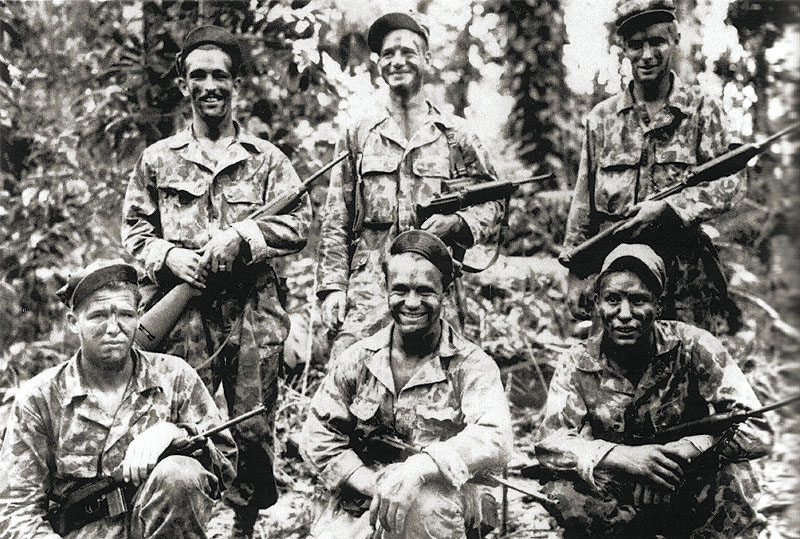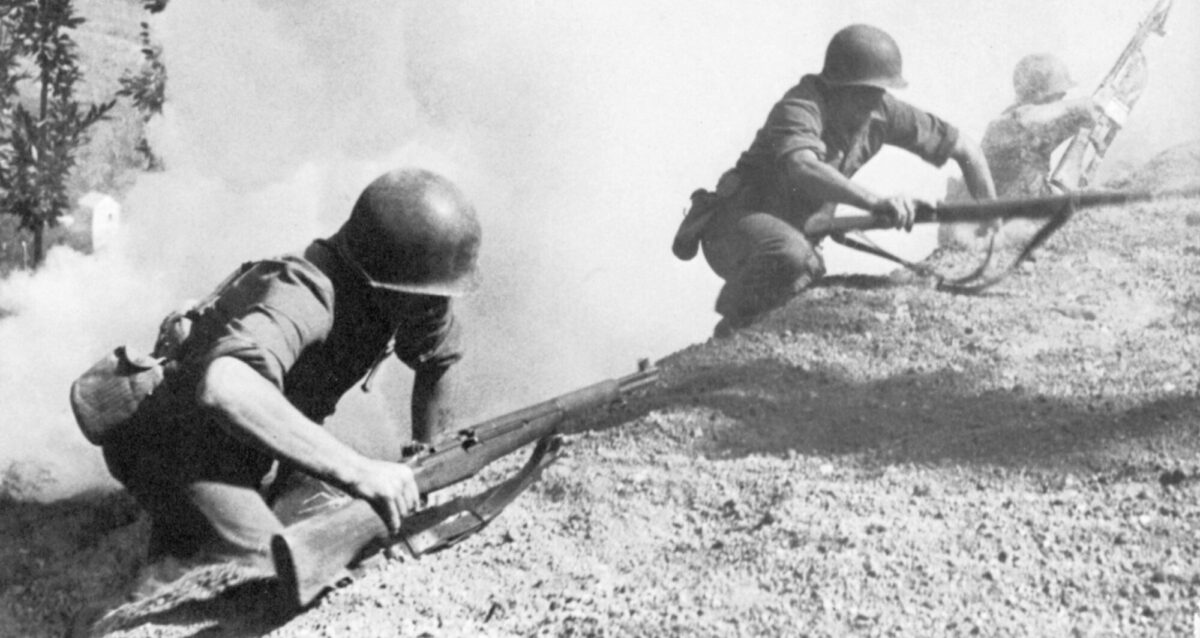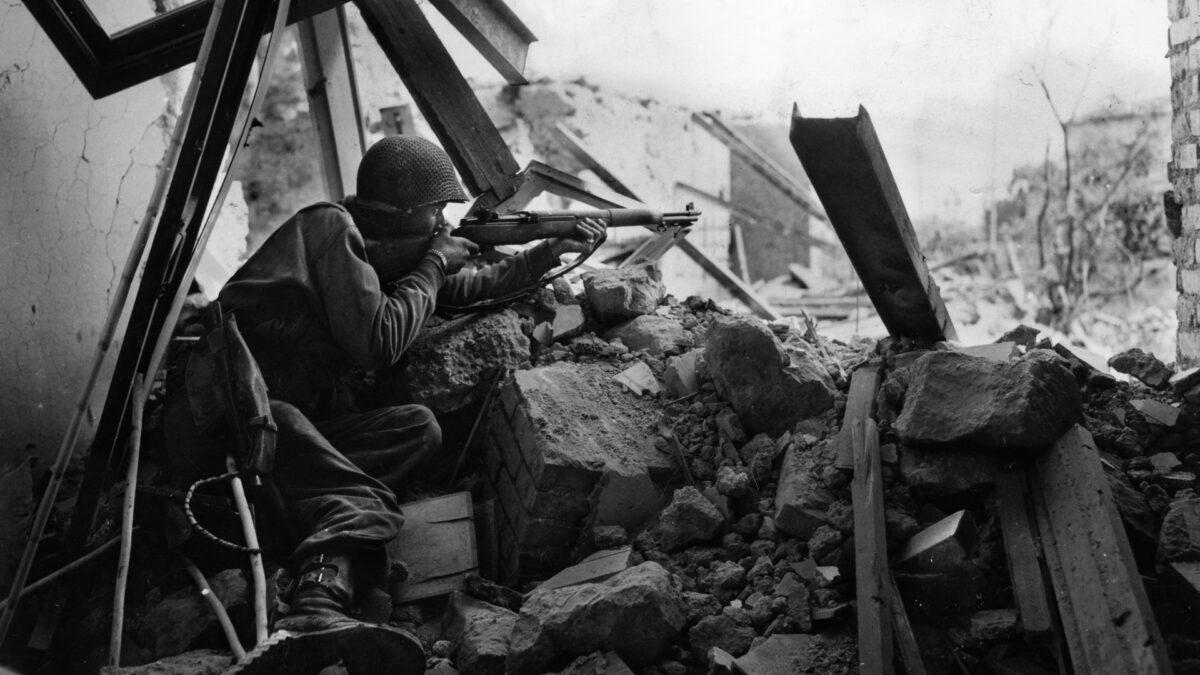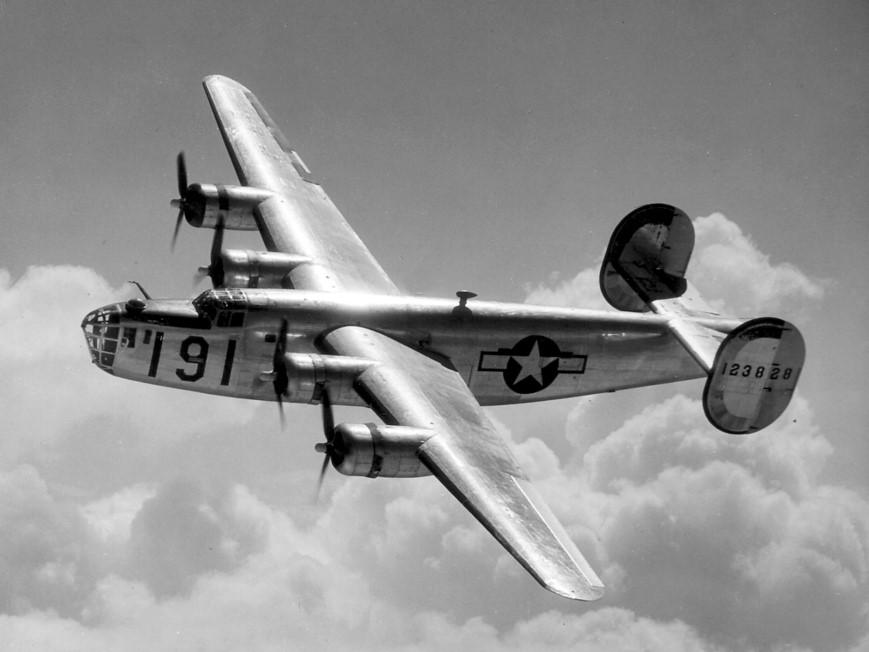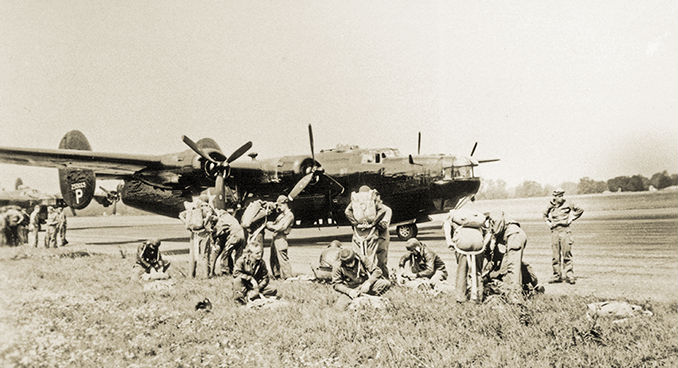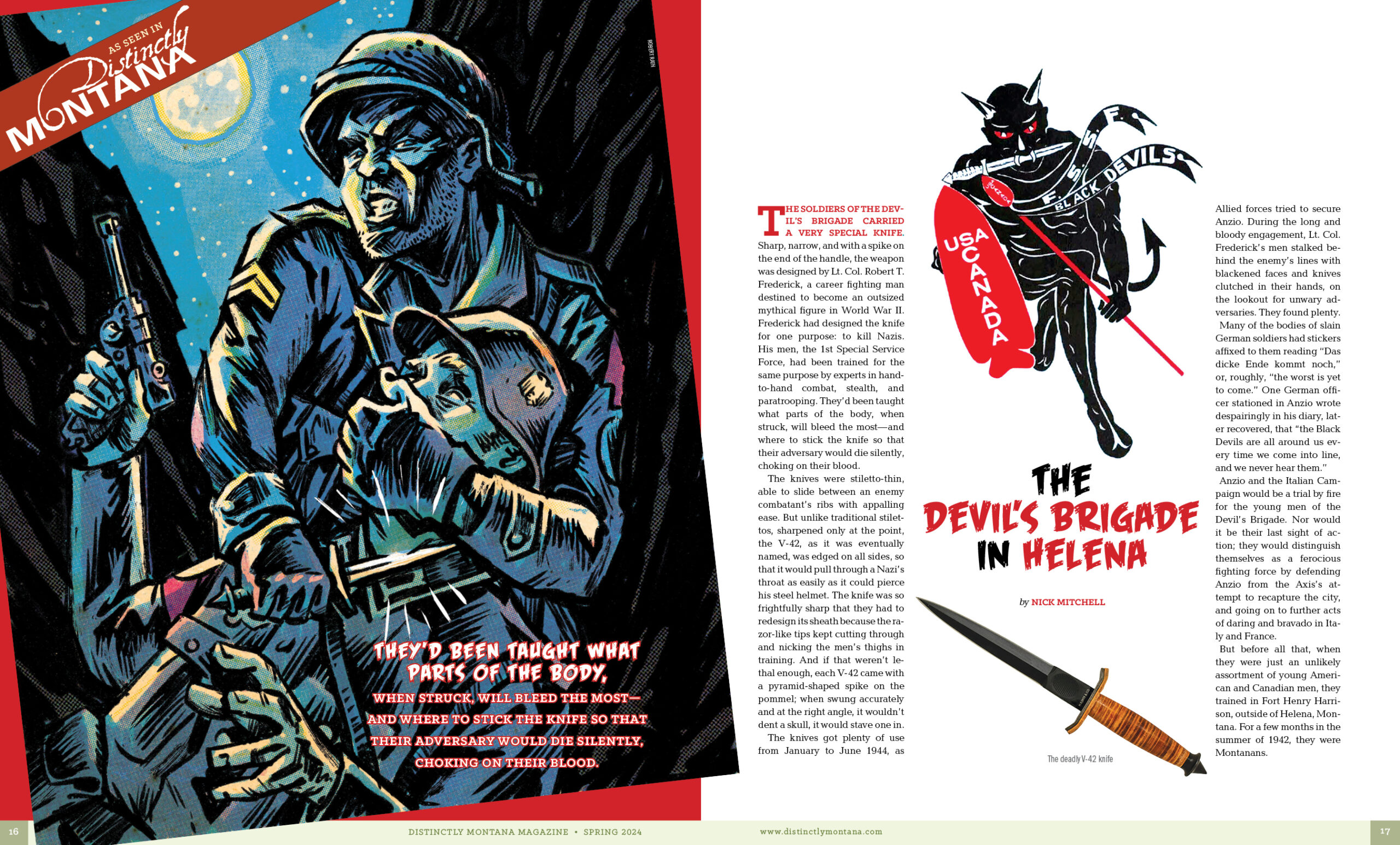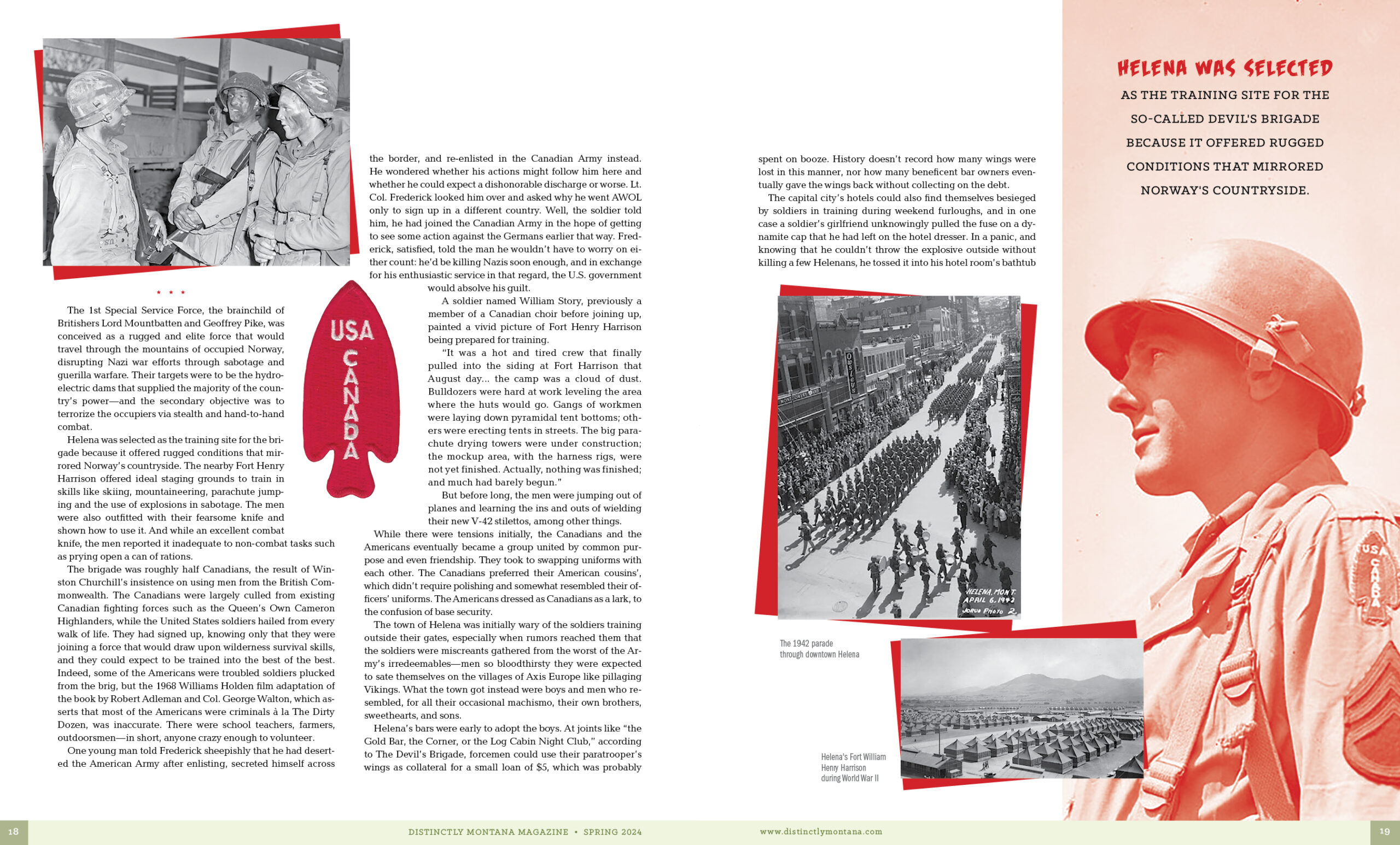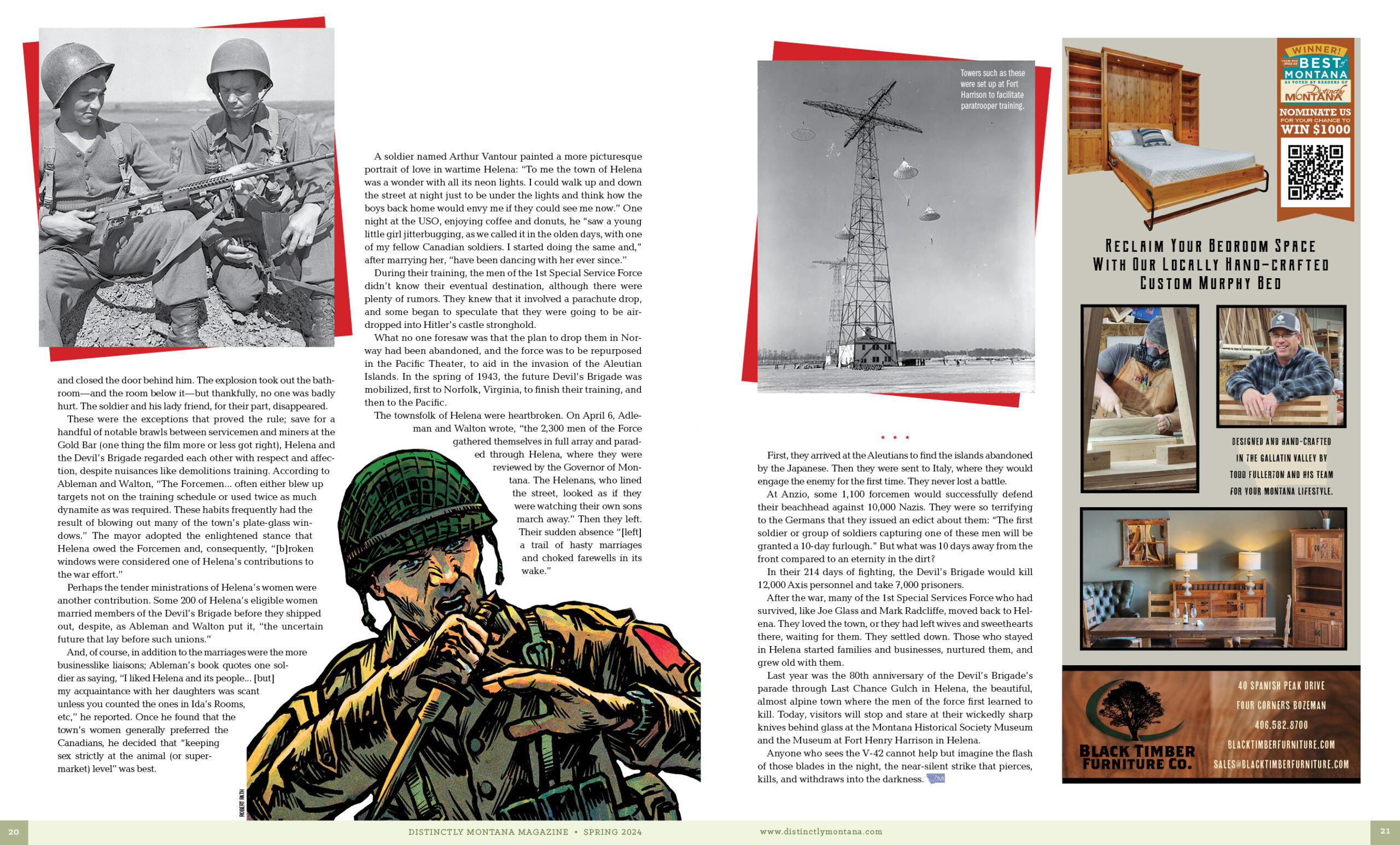After World War II ended, a group of Fort Ord-based army officers were enjoying a drink in their favorite bar, under the Sausalito end of the Golden Gate Bridge, when a policeman walked in. His eyes scanned the dimly lit, smoky interior and settled on something that seemed out of place–a soldier with a mustache and two silver stars on each shoulder who looked much too young to be a major general. He was obviously an impostor.
Approaching him, the policeman asked to see some identification. The officer complied, handing his ID card to the policeman. The cop glanced at the photo on it and the rank–major general. ‘Damned good forgery,’ the cop told himself as he flipped the card onto the grimy floor. A split second later, the policeman was lying next to the ID card, his jaw already beginning to swell from the force of the blow that had just been delivered by the mustachioed general. The young man wearing two stars was, in fact, Maj. Gen. Robert T. Frederick, creator and commander of the 1st Special Service Force, one of the most feared–and most fearless–fighting units ever assembled.
Robert Tryon Frederick, son of a San Francisco doctor, impressed almost no one during his four years at the U.S. Military Academy at West Point. He graduated 124th out of a class of 250 in 1928. The best that could be said of him was that he was an excellent organizer. The academy yearbook, The Howitzer, was not exactly effusive in its description of Frederick: ‘He has a natural and a modest personality that is bound to please.’
Frederick’s early military service was equally unremarkable. Following graduation he was assigned to the Coast Artillery, serving at Fort Winfield Scott in California. He toiled anonymously with that branch for over a decade, graduating from the Coast Artillery School at Fort Monroe, Va., in 1938. He then attended Command and General Staff School at Fort Leavenworth, Kan. Two years later he was a major, shuffling papers in the operations department of the War Department General Staff.
By the time the United States entered the war on December 8, 1941, Frederick had been promoted to lieutenant colonel, but he was still shuffling papers at the War Department. One of his duties was to pass judgment on ideas submitted by naive but well-meaning civilians who wanted to contribute to the war effort.
In May 1942, Frederick reviewed a report that boasted a long list of endorsements–including those of British Prime Minister Winston Churchill and American General George C. Marshall, chairman of the Joint Chiefs of Staff. The report detailed a plan (Project Plough) involving a diversionary invasion of Norway with a highly trained guerrilla band that would strike deep behind enemy lines. In his memo to his boss, Maj. Gen. Dwight D. Eisenhower, Frederick dismissed the idea as militarily unworkable.
The Army did not completely kill Project Plough; it opted instead to proceed with the planning stage, in order to cement British-American solidarity. When someone was needed to command the fledgling project, Eisenhower called Frederick into his office in early June and awarded him the job, declaring: ‘You take this Plough project. You’ve been over the whole thing. You’re in charge now. Let me know what you need.’
By late summer 1942, a unit of Americans and Canadians at Camp William Henry Harrison, near Helena, Mont., was training under the command of 35-year-old Colonel Frederick. Since there was no precedent for the type of multinational guerrilla force he was forming, Frederick was given carte blanche to build the unit as he saw fit. He envisioned three ‘mini-regiments,’ each with about 800 men divided between two (instead of the usual three) battalions. For his troops, Frederick wanted recruits who were strong, intelligent and accustomed to working out of doors in the harshest conditions. He and his staff officers combed American units training in the Southwest and Pacific Northwest for single men between ages 21 and 35…within the occupational range of lumberjacks, forest rangers, hunters, north woodsmen, game wardens, prospectors, and explorers’ and requested similar recruits from the Royal Canadian Army. The Canadian troops that soon began arriving at Camp Harrison were some of that nation’s finest volunteers. American unit commanders, on the other hand, were understandably reluctant to let their best soldiers go. As a consequence, many of the Americans ‘volunteered’ for the new unit were delivered to Helena directly from military stockades. It was an odd mix, but one that turned out to work surprisingly well in combat. Frederick immediately set about whipping his tough hombres into a cohesive military formation.
While the recruits were tough (one of the American officers reportedly kept a footlocker full of live rattlesnakes under his bed), the training was tougher. Reveille was at 0445 hours, and physical-fitness training lasted all day, with lectures extending well into the night. Instead of the normal marching cadence of 120 steps per minute, the unit marched at 140 steps per minute, and 50-mile hikes with full field gear were the norm. Every man–chaplains included–was required to become an expert with a wide variety of weapons, and knife-fighting techniques were taught with special relish. They learned how to kill silently with their bare hands and how to fight dirty, showing no mercy. They became demolition experts and skilled at using the enemy’s weapons.
Because they still expected to fight in Norway, cold-weather training was essential, and skiing and snow-shoeing went on throughout the bitter Montana winter of 1942-43. So did parachute training, for that was how they expected to enter Norway. Men who could not keep up the grueling pace or who ‘froze’ in the door of a Douglas C-47 during a jump were washed out. And Frederick pushed himself just as hard as he pushed his men.
The unit needed a name. ‘Braves’ became a sort of an unofficial moniker. But Frederick came up with ‘Special Service Force,’ which he preferred because it gave nothing away. Some people even thought it was part of the Army’s entertainment arm, the Special Services.
Although most of Helena embraced the multinational force, a few locals caused problems. One night while the Americans and Canadians were drinking together at a bar, a handful of miners began making unflattering comments about some of the kilt-clad Canucks. While the Canadians stoically ignored the remarks, their Yank comrades beat the stuffing out of the miners. Shortly thereafter, American uniforms were issued to everyone in the force.
While the Yanks and Canucks generally got on well with one another (they were integrated in each platoon and company, not segregated by nationality), the Yanks were paid more than their northern neighbors, which caused some friction. What diffused the tension somewhat was that the Yanks were paid once a month and were usually broke a day or two after payday, but the more frugal Canadians were paid twice a month and always seemed to have a few extra dollars to loan to their comrades from the south.
As training for an invasion of Norway continued, contingency plans were considered for other missions–to drop the force into Romania to destroy German-held oil fields and pipelines; to descend upon Italy and destroy the electricity-generating capabilities in the mountainous north. Both plans were scrapped. The unit would now concentrate solely on Norway.
In the autumn of 1942, Frederick flew to England to work out what he thought would be last-minute details about the Norway operation, dubbed Operation Sledgehammer. Instead, he learned this mission also had been scrubbed.
Frederick was disheartened. What could he tell his men, whom he now regarded as potentially the most effective fighting unit ever assembled? The Allies were fighting in North Africa, a theater that had no use for the force’s winter training. Questions were raised
about the need for the force at all during that period.
Returning to the States, Frederick discovered that the Canadian government was on the verge of pulling the plug on future Canadian participation in the amalgamated unit. General Marshall intervened, however, and persuaded the Canadians to stick with it.
Back in Montana, Frederick and his staff informed the Braves of what had transpired and assured them they would undoubtedly soon have a combat role. Their training began taking on a broader focus. Mountain climbing gained new emphasis, and the men perfected their skills at operating the Johnson light machine guns, flamethrowers, mortars, demolitions and a new shoulder-fired rocket launcher nicknamed the ‘bazooka.’ A new amphibious tracked personnel carrier, the T-24 (later standardized as the M-29) Weasel, also arrived.
Rumors of a variety of missions floated around Camp Harrison–the Caucasus Mountains, New Guinea and elsewhere. Yet the first overseas assignment turned out to be much closer to home, on the island of Kiska at the far end of the Aleutian chain, some 1,000 miles west of the Alaska mainland. The Japanese had captured nearby Attu Island, and it took a superhuman effort and many casualties for the Americans to retake the island. A larger, even better entrenched enemy was known to be waiting on Kiska.
In April 1943, the force left Montana to undergo amphibious training at Norfolk, Va. Frederick’s men performed so well that they completed their training a week before the course was scheduled to end. The men had grown bored with the training, which they considered too easy. For amusement they began picking on Marines in Norfolk, disarming them on the street. The Marine base commander was displeased by those shenanigans and ordered Frederick to curtail his unit’s extracurricular activities or his men would be thrown into the brig. Instead of complying, Frederick bet the Marine general $10 that his men could overcome the base’s tight security. The general took the bet. The next morning, Frederick drove the general around the base, showing him where his men had planted simulated demolitions during the night–including under the base commander’s own bed!
After Norfolk, it was on to Chesapeake Bay, where the force set more records in loading from transports into landing craft. Frederick’s men then moved to Fort Ethan Allen, Vt., where they practiced river-crossing techniques on Lake Champlain. They were then shuttled to the West Coast and, in July 1943, set sail with 40,000 other troops for the invasion of Kiska, the largest amphibious assault of the war up to that point. Paddling ashore in the dark in rubber boats, the men rapidly reached their assigned beaches, expecting the enemy to open up on them the moment they hit the shore. But all was silent. The 12,000 Japanese on Kiska had been secretly evacuated by sea a few days before the invasion forces landed. Some of the Allied units remained to garrison the barren, windswept island, while Frederick’s force was ordered to Italy, where it arrived two months after the nearly disastrous Allied landings at Salerno.
Lieutenant General Mark Clark’s Fifth Army–a mixture of American and British units–had run up against the German Gustav Line at the southern entrance to the Liri Valley. Rome lay less than 100 miles to the north, and Field Marshal Albert Kesselring’s troops were determined to make the Allies pay in blood for each inch of ground. Stretching across the mountains and fields from the Ligurian Sea to the Adriatic side of Italy, the Gustav Line bristled with bunkers, pillboxes, minefields and gun emplacements. The Allies were faced with the challenge of trying to break through a nearly impregnable wall defended by a battle-hardened, well-entrenched enemy during what would be one of Italy’s worst winters.
On November 22, 1943, the 1,800-man-strong 1st Special Service Force (1st SSF) was attached to Maj. Gen. Fred L. Walker’s 36th Infantry Division, a National Guard outfit from Texas. The 1st SSF was to spearhead the Fifth Army’s drive against Monte la Difensa and Monte la Remetanea, about four miles south of a village called San Pietro. The two rugged mountains guarded the entrance to the Mignano Gap, southeast of Cassino, which was scheduled to be assaulted by the U.S. 3rd Infantry Division. It was a tough assignment for an outfit that had never seen combat.
The attack was set for December 2. Since Monte la Difensa was closer to the Allied lines, it would be the first assaulted. The 3,120-foot mountain is an impressive sight, with a 200-foot cliff starting at 2,000 feet above sea level on its north side and six ledges rising above it, each roughly 30 feet apart. On top of the mountain were veterans of the 15th Panzergrenadier Division. The Germans had already repulsed other Allied attempts to take the high ground, and corpses littered the slopes. Frederick personally reconnoitered the mountain, along with a handful of his best men, looking for routes to the top.
At dusk on December 1 the Braves were hiking 10 miles through a cold downpour while artillery shells from both sides shrieked overhead. As the troops neared the mountain, Allied shells plastered it. ‘It looked like the whole mountain was on fire,’ said one man.
Throughout December 2, Frederick’s men dug shelters into the mountainside, to await the order to begin the attack on the 4th. As darkness descended, the Americans and British began a fearsome barrage. Before dawn on the 4th the SSF emerged from their holes, their faces blackened with burnt cork, their weapons loaded, their knives sharpened to a fine edge. Sensing imminent attack, the Germans brought down artillery and mortars on the most likely approach routes.
With ropes where necessary, men of the 1st SSF’s 2nd Regiment, many lugging machine guns, climbed for hours with stiff, frozen hands to finally reach the rain-slicked, rocky ledges above the sheer cliff. They lay there as still as stones and were soon glazed over, encased in icy shells. The men were so close to the German positions that they could smell food being cooked and hear the enemy cursing the steady rain. Right behind the advance elements came Frederick and his staff.
At the appointed hour, the men slithered from their rocky perches into the entrenchments of the German outposts, silently slitting the throats of the guards. No one was supposed to fire until 0600 hours, but when a section of loose rock clattered down the cliff, the Germans were alerted and began sending flares up and shells down. Bullets rattled and whined back and forth in the dark. Both sides exchanged grenades, their targets illuminated only by explosions or the constant popping of aerial flares. A 1st SSF captain was trying to take a surrendering German prisoner when the German’s comrade sprang from his hiding place and shot the officer point-blank in the face, killing him. From then on, Frederick’s men took no prisoners unless specifically ordered to do so for interrogation purposes.
Frederick was in the thick of the fight, giving orders, repositioning machine guns and firing at the enemy with his own .45. Two hours after the battle began it was over. Those Germans lucky enough to be alive scrambled down the mountain as fast as they could. Thinking that the enemy would probably stage a counterattack against his men, whose supplies were running out, Frederick radioed the troops below to begin hauling supplies to the summit, a six-hour trip. When the pack mules were unable to make the steep climb, men lugged the food, water and ammunition on their backs, each man making two or three climbs a day and returning with dead and wounded.
Although Monte la Difensa was in American hands, the Allied position was not as secure on the other nearby peaks. The British had taken a neighboring mountaintop monastery, only to lose it to a German counterattack. Instead of waiting for the anticipated German counterattack on la Difensa, Frederick decided to attack Monte la Remetanea at dawn the next day.
That night was wretched. Cold, unrelenting rain beat down on the unprotected men, as did an unending rain of German mortar shells and rockets from the new multibarreled Nebelwerfer rocket launchers nicknamed screaming mimis’ by the Americans. The force’s 1st Regiment, commanded by Lt. Col. Alfred C. Marshall, began to take casualties from the shelling.
Because of the heavy enemy fire, the SSF assault on Monte la Remetanea was delayed for a day. A thick fog settled over the mountain, providing the 1st SSF concealment but no cover. Moving out one by one, or in small patrols, Frederick’s men crept through the fog to kill Germans in their foxholes, up close and personal. Soon the entire southern slope of the mountain was in 1st SSF hands. At nightfall, Frederick directed his assistant commander, Colonel Paul D. Adams, to round up 15 cases of bourbon to warm and reward his men. The Fifth Army filled the requisition without hesitation.
The next day, the 1st SSF moved out to eliminate a particularly troublesome group of Germans located in a monastery in the saddle between two hills. Although outnumbered 4-to-1, the men filled the air with their battle cries and savagely attacked the enemy positions. German soldiers who failed to retreat were killed on the spot. No prisoners were taken.
The following day, December 6, the exhausted men resumed their attack, overcoming snipers and enemy artillery until, finally, the beaten Germans pulled out. The price of Italian real estate during the three-day battle was high–73 1st SSF men killed and another 459 wounded. Frederick himself was hit twice. Their sacrifice and the heroism of those who survived enabled the Allies to gain control of the southern approaches to Monte Cassino and the Liri Valley. One war correspondent reported, ‘This feat captured the imagination of the entire Fifth Army and overnight Frederick and his soldiers became almost legendary figures in a battle area where heroism was commonplace.’
There, however, the war in Italy reached its first stalemate. The entrance to the Liri Valley, which led directly to Rome, was flanked by rows of formidable mountains and guarded by some of Hitler’s toughest soldiers. The Germans were not about to allow the Allies to stroll unchallenged into the Eternal City. Attention was focused on Monte Cassino, crowned by its ancient Benedictine monastery, and Cassino, the town below. From the heights, the Germans could observe anything that moved in the valley and bring devastating artillery fire down upon it.
Getting the Fifth Army in position to attack Monte Cassino was no easy feat in itself. Two mountainous ‘jaws’ guarded the approach to Monte Cassino on Highway 6. Monte Lungo, to the south, and Monte Sammucro, a towering crag that loomed spectacularly over the mountainside village of San Pietro, were both held by the Germans. The Allies had to seize both before the all-out assault against Monte Cassino could begin.
The first phase of the operation to evict the Germans from the area called for battalions from the 36th Division and 504th Parachute Infantry Regiment of the 82nd Airborne Division to push the enemy off Sammucro’s crest. Then the Italian 1st Motorized Division, which came over to the Allied side following Italy’s capitulation in September 1943, would assault the Germans on Lungo. Both phases of the operation quickly ran into trouble. The Italian attack was forced back, while the Americans managed to push close to San Pietro but were pummeled by German guns firing from Lungo. Every attempt to take the village, including an assault by 16 tanks on December 15, ended in failure and many casualties. Later that same day, however, the 36th’s 142nd Regiment successfully drove the Germans off Monte Lungo, forcing the enemy to pull back from the San Pietro¬Monte Lungo positions.
Clark decided to exploit this crack in the German defensive line by sending the 1st SSF (which had been resting and recuperating for more than a week), the 1st Armored Division and the 34th Infantry Division into the valley and over the mountains toward Cassino, less than 15 miles away. The 1st SSF’s objective was Hill 720, the westernmost spur of Monte Sammucro. The 1st Battalion of the 36th Division’s 141st Regiment would assist Colonel Marshall’s 1st Battalion of the 1st SSF. On December 23 the attacks began across Sammucro’s cloud-shrouded peaks, with Frederick in the lead. It quickly became apparent that communications with the 141st Regiment and 504th Parachute Infantry, operating on the SSF’s right flank, were inadequate, and a 24-hour delay was instituted so that the problems could be fixed. Rain beat down on the attackers as they prepared for H-hour, set for 0300 on Christmas Day. An hour before the assault began, however, the Germans nearby shelled the Americans, who replied with their own big guns. The slugfest raged for hours, and the casualties were appalling. One 1st SSF company was eventually down to seven or eight men. But by early afternoon, all objectives had been taken by the 36th, the 504th and the men of the 1st SSF.
As a year-end blizzard enveloped the peaks of the area, bringing most Fifth Army offensive action to a temporary halt, plans were made to resume the broad-front attack to break into the Liri Valley. The French Expeditionary Corps took up positions on the right flank that had been held by the exhausted 45th Infantry Division, which had been in nearly continuous combat since the Salerno landings in September. The new operation, scheduled for the first week of January, called for the British X Corps to capture Cedro Hill while the II Corps attacked Monte Porchia and prepared to cross the Garigliano River near Sant Ambrogio.
Reinforced with extra artillery and two battalions from the 34th Infantry Division’s 133rd Regiment, the 1st SSF was trucked a few miles northeast of Monte Sammucro in preparation for an assault against Monte Majo. Once that proved successful, the 1st SSF was to continue on to the southwest toward Cervaro, about three miles east of Cassino. The 2nd Regiment, commanded by Lt. Col. Robert Moore, would take Monte Radicosa, while the 3rd Regiment, under Lt. Col. Edwin Walker, was assigned Monte Majo. Not even Colonel Marshall’s badly decimated 1st Regiment was let off the hook–Hill 1270 and Vischiataro Hill were its objectives.
In the snow, the Italian landscape looked deceptively as pretty as a Christmas card. But the Germans had sown the area with mines and had zeroed in their artillery and mortars to cover the most likely avenues of approach. As always, Frederick personally took part in reconnoitering the objectives and demanded the same from all his officers.
Patrols gathered intelligence on the enemy, and supplies were brought forward to await the attack. Under cover of darkness on the frigid night of January 4, 1944, the 1st SSF moved out. Crawling to within grenade range of a line of machine-gun nests, one company surprised and killed some 100 Germans. Another element shunned a stealthy approach in favor of a frontal attack and eventually reached the summit of Radicosa, although outnumbered 2-1 by the Germans. In the dark, Marshall’s 1st Regiment swung east of its objective, then swooped in, taking the defenders by surprise.
After dark on the 7th, the same courageous actions were repeated by Walker’s 3rd Regiment on nearby Monte Majo. The all-night battle began at 1000 and lasted until dawn, when the summit was in 1st SSF hands. For the next three days the Germans launched one counterattack after another at the 1st SSF, only to be hurled back with horrendous casualties. Elsewhere along the front, other Fifth Army units were making good progress against stiff resistance.
What the enemy could not stop, nature did. The cold was so bitter that, in one 75-man group on Monte Radicosa, 44 were evacuated with frozen feet.
The sounds of battle gradually ceased echoing off the mountains. By January 15 the Fifth Army stood at the gate of the Liri Valley. But German resistance was building west of the Rapido River in the Gustav Line fortifications. The brutal winter weather had arrived in earnest, and Clark’s men were on the verge of exhaustion. Both sides dug in to watch and wait. The stalemate along the Gustav Line had begun.
During this period of relative inactivity, the 1st SSF–or what was left of it–was trucked back to a rest area. Frederick’s losses were staggering: Of 1,800 combat troops, only 400 were left alive or unwounded. Even the litter-bearers and porters in the service battalion were at half strength. The next several weeks were spent absorbing and training replacements, volunteers and men specially selected from the replacement pool as having the same spirit, determination and indifference to danger that had characterized the original force.
Unknown to the men, a new operation was in the works. Code-named ‘Shingle,’ this plan was conceived by Winston Churchill as a way of breaking the Gustav Line stalemate at Monte Cassino and at the mouth of the Liri Valley. On January 22, 1944, the first phase of Shingle, under the aegis of VI Corps’ commander Maj. Gen. John P. Lucas, hit the beaches around the resort town of Anzio, some 70 miles up the coast from the Gustav Line and only 35 miles south of Rome. The 1st SSF would soon find itself occupying a key position at Anzio. The first Allied troops ashore at Anzio, and the neighboring town of Nettuno, were Maj. Gen. Lucien Truscott’s U.S. 3rd Infantry Division and Maj. Gen. W.R.C. Penney’s British 1st Infantry Division, along with Colonel William O. Darby’s Ranger battalions. The landing force was too small to do much more than establish and build up a beachhead–and to endure endless artillery barrages and fight off vigorous German counterattacks.
Frederick spent a few weeks training replacements and welcoming back wounded soldiers–some of them AWOL from the hospital–still stitched and bandaged but not wanting to miss the action. Arriving at Anzio on February 1, the 1st SSF, now built up to 2,300 men, was given responsibility for a front of nearly 10 miles. Most of the assigned front was along the Mussolini Canal and faced the vast Pontine Marshes, which formed the right flank of the beachhead and were virtually impassable to men and armor.
Unaccustomed to a static role, and not content to simply guard a stretch of swamp, the 1st SSF men began mounting nuisance raids into enemy territory. Sending nightly patrols deep behind enemy lines to bring back prisoners and to generally raise hell, they quickly gained a reputation among the Germans as a unit to avoid. Their blackened faces gave rise to a new nickname: Schwartzteufeln, or ‘Black Devils.’
The 1st SSF was filled with colorful characters, and legends grew up around most of them. One night, for example, a patrol from the 1st Regiment entered the abandoned town of Borgo Sabotino, a quarter of a mile behind German lines. Proclaiming himself ‘mayor,’ 1st Lt. Gus Heilman changed the name of the place to ‘Gusville.’ The town had certain amenities, such as a sizable supply of cows, horses, pigs and chickens. Those soon replaced C- and K-rations and were washed down with wine and other beverages ‘liberated’ from nearby German units.
During the rare quiet moments at Anzio, the men devised a variety of activities to keep themselves amused, including baseball, volleyball, horse racing, farming in no-man’s land, and raiding U.S. VI Corps headquarters for large casks of wine. A newspaper, the Gusville Herald-Tribune, soon hit the streets, and the town was frequented by war correspondents who braved enemy fire just so they could file their stories with the dateline ‘Gusville, Italy.’ As Robert H. Adleman and Colonel George Walton, authors of the book The Devil’s Brigade, wrote: ‘Gusville had a considerable effect on the morale of all the soldiers at the Anzio Beachhead…the casual disinclination of forcemen like Gus Heilman to consider their situation a serious predicament made all Allied soldiers feel better. They saw that the Force was not only refusing to be content with self-preservation, they were enthusiastically launching and winning a series of offensive actions. More than one Allied commander observed, ‘the force gave heart to everybody.”
The soft-spoken, unassuming Frederick, now a brigadier general, usually eschewed gestures that smacked of bravado and machismo, but he hit on an idea that had more psychological effect than all the propaganda leaflets both sides shot at each other. He had stickers printed with the 1st SSF emblem and the German phrase for ‘The worst is yet to come.’ After killing a German, the SSF would paste one of the stickers on the forehead or helmet of the victim, as a warning to the dead soldier’s comrades.
Killing was not the only skill at which the 1st SSF men excelled. They were also quite adept during their nightly patrols at slithering quietly into enemy positions and bringing back as prisoners’ whole platoons and even companies. By the same token, the men were extremely difficult to capture. Of the entire 1st SSF, it is estimated that fewer than 30 were ever taken prisoner.
The ability of Frederick’s men to laugh at death and injury is legendary. One 1st SSF man, after having one of his legs blown off by a mine, is said to have reported to the surgeon and asked, ‘Hey, doc, got an extra foot around this place?’
Near the end of May, however, the good life at Anzio came to a halt as the full-scale breakout from the beachhead drew near. The 36th Engineer Combat Regiment relieved the 1st SSF west of the Pontine Marshes on May 9, and the 1st SSF men were paired up with the 3rd Division. After Darby’s Rangers had been nearly wiped out during their disastrous raid on Cisterna on January 30, 1944, a number of surviving Rangers were reassigned to the 1st SSF as replacements. They were amazed by the toughness and audacity of Frederick’s unit. Canadian units, too, were scoured for volunteers to replace those who had fallen. Six times as many men volunteered as were needed.
The breakout from the beachhead began in furious style early on May 23, 1944. Swiftly overwhelming the enemy in their fixed fortifications, the Allies surged northward in hopes of linking up with other British and American forces rushing up through the Liri Valley, having at last smashed through the Gustav Line defenses. All went surprisingly well for the 1st SSF men until that afternoon, when they encountered 17 Mark VI Tiger tanks. For perhaps the only time in its history, the 1st SSF men wisely waited until the panzers were driven off before plunging ahead.
To say German resistance was stiff would be a monumental understatement. Every village, barn and intersection were guarded by machine guns and 88s. Many 1st SSF soldiers were killed or wounded in the fearsome fighting around Artena. Frederick himself was hit again. But the inexorable Allied advance continued.
By June 3, the American Fifth and the British Eighth armies were at the gates of Rome. Declaring it an open city, the Germans pulled back to the north, with enough guns, tanks and snipers left behind to make life miserable for the advancing Allies. At 0630 on the 4th, an advance patrol of the 1st SSF entered the Eternal City through the Porta San Giovanni. Captain Taylor Radcliffe, the patrol’s commander, was the first Allied soldier to enter Rome. Frederick was wounded three times that day.
After a few days in bivouac near Rome, listening to news of the Normandy invasion, the exhausted, lice-ridden men were trucked to Lake Albano, near the pope’s summer residence at Castel Gandolfo, for some well-deserved rest and recuperation. Soon back to their old tricks, nearly every man was seen driving his own jeep–each of which had been stolen from some other unit. A considerable number of pieces of furniture from the pope’s residence also ended up gracing 1st SSF quarters.
The days and weeks rolled by as the 1st SSF luxuriated in the Roman sun and the waters of Lake Albano. Then, on June 23, Frederick made an announcement that stunned everyone in the unit: He was being promoted and transferred to command a newly formed unit, the 1st Airborne Task Force, for the invasion of southern France. Some of the toughest soldiers in the world cried openly at the news.
Assuming command of the 1st SSF was Colonel Edwin Walker, the 3rd Regiment’s CO. Following in Frederick’s footsteps would have been a tall order for anyone, but Walker, a tough and able commander, simply did not possess the charisma of the unit’s founder. Frederick’s men would have walked barefoot through hell for him; they were less enamored of his successor.
After being moved to the Salerno area, the 1st SSF began training for its next to the last combat role–the U.S. Seventh Army invasion of southern France, known as Operation Dragoon, on August 15, 1944. The 1st SSF’s assignment was to seize two of three small islands between Toulon and the Riviera where there were ancient forts that the Germans had strengthened. By taking them, the 1st SSF would protect the rest of the invasion force from enfilading fire from the left flank.
With a little help from the Navy’s big guns and the U.S. Army Air Forces’ bombers, the 1st SSF men crawled, charged and blasted their way into the German fortifications on Ile de Port-Cros and Ile du Levant, losing many good men due to unnecessary acts of bravado. ‘The men were too courageous,’ one 1st SSF man said later. ‘They had a mistaken concept that courage and physical fitness were all that was necessary.’
The islands were secured by August 16, while the rest of the Seventh Army rolled northward through southeastern France. The 1st SSF, however, moved eastward along the Riviera against substandard, rear-guard enemy units, finally taking up positions along the French-Italian border. There the men stayed, their prodigious fighting talents wasting away as the war moved on. Previously, many wounded 1st SSF men had gone AWOL from the hospitals where they were recuperating in order to rejoin their unit and the fighting. Now, disgusted with the lack of action and the rumored likelihood of the unit being disbanded, many of the men went AWOL for good.
As the war in Europe entered its final six months, further changes were made in the Allied armies. In November 1944, the 1st Airborne Task Force was dissolved, and in December Frederick was made commanding general of the 45th Infantry Division, which was locked in fighting in the Vosges Mountains, close to the German border. Wounded nine times during the war, Frederick was praised by Churchill as ‘the greatest fighting general of all time.’
The 1st SSF’s days were numbered. Without Frederick at the helm, and unable to find the caliber of men necessary to fill out its diminished ranks and carry on its glorious tradition, the 1st SSF was doomed to be disbanded, its officers and men reassigned to other units.
Another, more important reason signaled the end of the unit. Lieutenant Colonel Robert D. Burhans, author of the book The 1st Special Service Force, wrote: ‘The day of small assaults was past. The war had grown into a mass operation of army groups pitted in the final struggle, and who could use 2,400 men? SHAEF wanted divisions, corps, armies.’ On December 5, 1944, the 1st SSF stood in ranks at Villeneuve-Loubet as its colors were struck. The Canadian contingent marched off smartly, followed by the Americans. It was an emotional moment for the men. One Yank related: ‘This was the day I saw some of the toughest S.O.B.s ever break down in tears. As the Canadians pulled out, some of us Americans ran alongside and behind the trucks for a mile with tears in our eyes.’
Some historians have called the 1st SSF a ‘glorious failure’–a highly specialized and trained unit that was never given the proper role in which to use its training. It excelled at mountain warfare but never made a parachute drop, nor used its ski training in snow-covered, enemy-held terrain, nor showed its capabilities as a shock force or guerrilla band behind enemy lines. Its incredibly courageous volunteers were squandered in set-piece battles or assigned to hold static frontage away from the crucial action.
Yet the 1st SSF–the forerunner of America’s Green Berets–proved that soldiers from two different nations could work effectively as part of an elite, integrated unit, drawing upon each other’s’ strengths and forming a remarkable cohesion that stemmed from the self-confidence of each of its members and a disdain for mindless regulation and regimentation.
Small, specialized units such as the 1st SSF did not, by themselves, win World War II for the Allies. Their value cannot be based on battles won or lost, or in the number of towns liberated or prisoners captured, or in the casualties inflicted upon the enemy. But perhaps their well-reported exploits and indomitable spirit in the face of overwhelming odds contributed in a major way to the optimism that, even in the darkest days of the war, kept whispering President Franklin D. Roosevelt’s words in every soldier’s and civilian’s ear: ‘We shall gain the inevitable triumph, so help us God.’
Source: HistoryNet: http://www.historynet.com/us-canadian-1st-special-service-force-in-world-war-ii.htm
Printed with permission
6/12/2006 • WORLD WAR II
